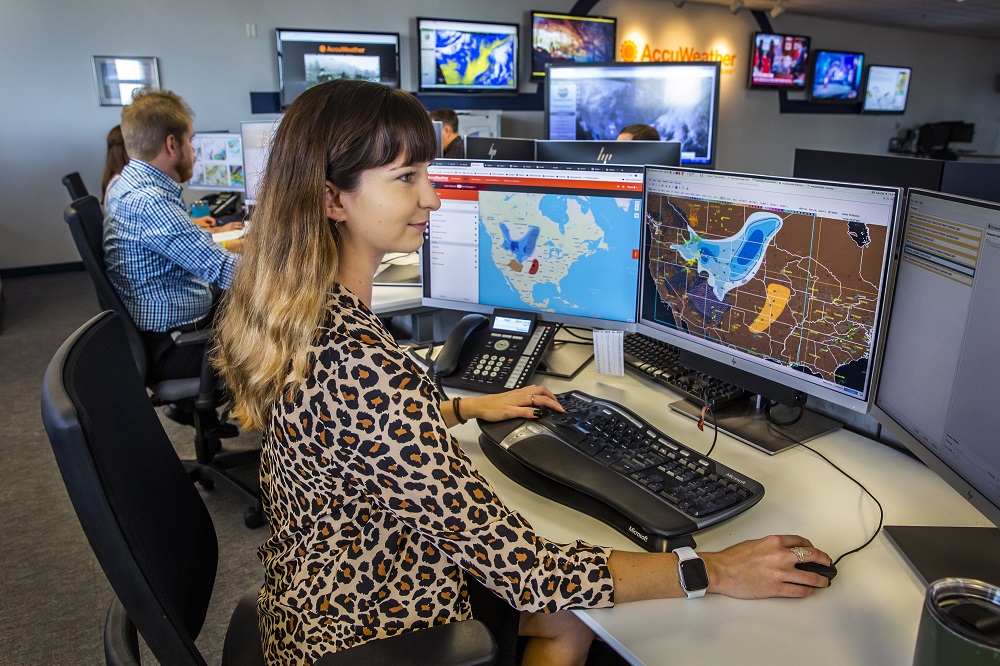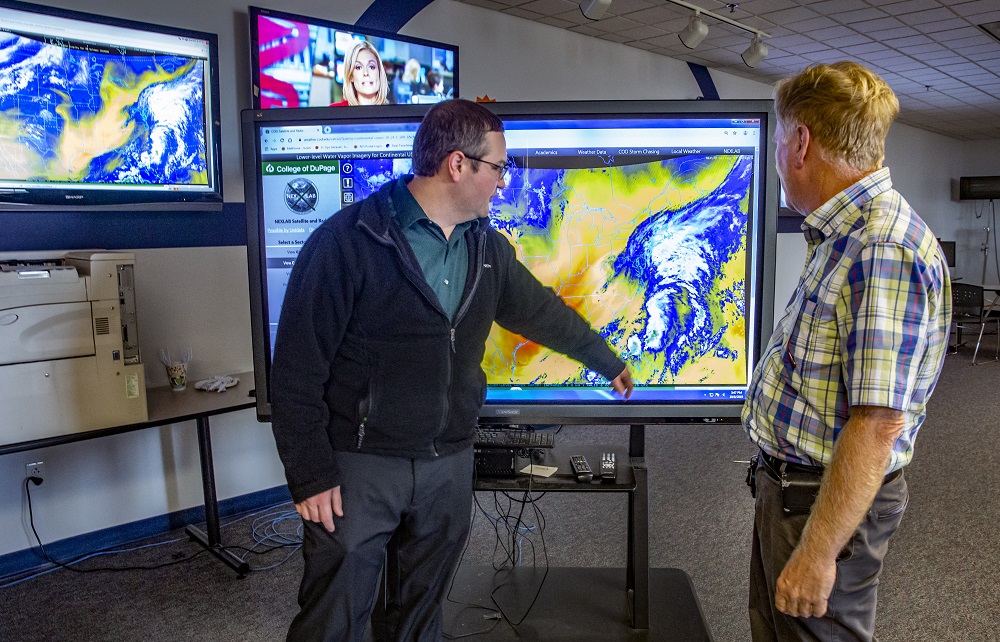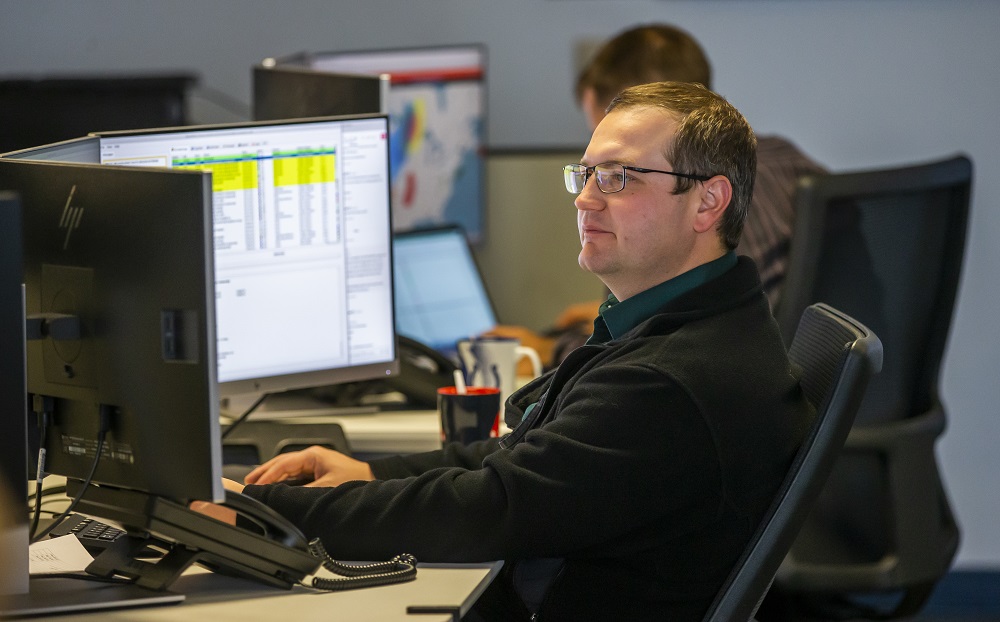Article
Data science is transforming weather forecasts
Jul 14, 2020
The use of artificial intelligence in data science is already transforming forecasts
Jul 14, 2020
The use of artificial intelligence in data science is already transforming forecasts
One day soon, you’ll be able to know just how much rain to expect at your address from an approaching thunderstorm.
Data scientists even foresee a day when meteorologists can project with remarkable accuracy where tornadoes are most likely to strike – not minutes head of time, but months in advance.
“That’s a game changer,” said Rosemary Radich, director of data science for the private forecasting service Accuweather .
Such projections aren’t the stuff of fairy tales and distant wish lists, Radich said.
The use of artificial intelligence in data science is already transforming forecasts, Radich said, and that impact will only intensify.
Weather is “one of the most enjoyable jobs for data science,” she said. “Weather impacts so much and there’s so much great weather data everywhere.
“There’s never a lack for data or interesting projects, that’s for sure.”
Using data science to identify patterns and trends, Accuweather’s Data Science and Long Range Forecast teams last winter created a computer forecasting model that predicted a high probability of tornadoes to occur in the Lower Mississippi Valley and the Deep South – commonly called Dixie Alley – and in portions of the Southern Plains.

A number of tornado outbreaks occurred in April – and more than 83 percent of the tornado tracks occurred in the areas highlighted by the forecasting model.
“We’re really on the forefront of innovation,” Radich said of Accuweather.
Artificial intelligence, or machine learning, and data science are helping drive this revolution in technology, she said
Weather is “the perfect case of machine learning,” Radich said.
Mother Nature provides a prodigious amount of data – such as temperatures, wind speeds, barometric pressure readings, dew points – and that data can be synthesized to identify patterns. That data can be fed to computer models used to generate forecasts, based on what similar data and patterns have produced in the past.
“We’re data detectives,” Radich said. “We’re always curious to see where we can find that next clue.”
“Weather is the perfect case of machine learning”
Rosemary Radich, Accuweather
Data scientists can monitor how the various computer models are performing under what conditions, Radich said, including which ones perform best over time in which conditions and which time of year and at which locations.
All of that information can then be fed back into algorithms to update the computer models, and meteorologists can use the updated model runs to fine-tune their forecasts.
The goal isn’t to replace meteorologists, Radich said, it’s to help them produce even better forecasts.
“I see it as a symbiotic relationship,” she said. “Someone has to apply what the AI is producing.”
With the explosion of data now being collected and the advent of high-resolution radars, Radich said, forecasters will be able to offer more exact snowfall and rainfall forecasts than ever before.
As last spring showed, data can help reveal “if there are geographical areas where different weather patterns are starting to emerge,” she said.

Are new hotspots for tornado activity emerging? Is Tornado Alley shifting or simply oscillating over a period of years?
Data science revealed “a big flaw” in how tropical storms were being categorized and how potential impacts were being communicated, Radich said.
“We were not looking at the amount of rain being produced” by hurricanes and tropical storms, she said.
Slower moving systems can produce torrential amounts of rain, leading to widespread flooding. Tropical Storm Imelda, for example, triggered massive flooding in south Texas last September.
“That’s something that’s really impactful to people, to businesses, to infrastructure,” Radich said.
“We’re working on developing a method for forecasting the scale of those systems. We have a lot of people working on it” across the weather industry, she said.
Offering more precise forecasts isn’t just about convenience, Radich said: It will be a key piece in convincing people to respond quickly and appropriately when severe weather threatens.
One of the challenges of using data to develop more precise forecasts is the inconsistency of records over the years, she said. Much more weather information was collected beginning in the early 1980s than previously, and still more in the last 10 years or so.
Claims, for instance, that far more tornadoes happen now than decades ago are flawed simply because the more sophisticated radars and proliferation of storm chasers that make tornadoes hard to miss in the modern age didn’t exist 40 or 50 years ago, she said.
With significant gaps in data collection many years ago, comparing current environmental conditions with those of decades ago can be a bit like apples and oranges, Radich said. But forecasters and researchers still look for similarities in search of telling clues.
With a background in sociology, Radich says she has a keen interest in how and why people react the way they do to severe weather watches and warnings.
“We have a saying – ‘If it were easy, it would be rocket science’ – when it comes to predicting human behavior,” Radich said.
Efforts have been under way for years to find more effective ways to convey information about weather threats to the public. Initial emphasis on the severity of the storms met with disappointing results, so officials are now focusing on how storms will impact those threatened.
“How can we message this information differently so people will respond appropriately?” Radich asked. “I’m up for the challenge. Weather is so interesting because it impacts so much of everyday life.”
Radich lives in Wichita and works out of Accuweather’s Wichita office. A native of Tacoma in the Pacific Northwest, she was baffled by how Kansans would react whenever tornado sirens blared.
Rather than head to the basement or other shelter, they routinely go outside to look at the sky.
“I’d be like, ‘No, don’t do that! Stay in your basement!’” Radich said, laughing.
Social scientists studying public response to violent weather in recent years discovered people typically want to confirm the threat before taking definitive action. For many, that’s going outside to see for themselves. For others, it’s turning on the television or calling a coworker or loved one.
“The challenge, really, is figuring out how do we quantify that relationship” with violent weather, Radich said. “How do we understand it? How do we forecast it forward?”
“One of the things we want to help with is the false alarm rates – making sure we can do the most accurate forecast possible,” she said. “Getting accuracy up over time, that should help with people’s response to it as well.”
Reducing the number of false alarms isn’t just a matter of sparing undue anxiety. It saves businesses money, Radich said, because they don’t have to unnecessarily halt production to get workers to shelter.

Some habits are already changing. Analytics tracking use of Accuweather’s mobile website show surges at least three times a day.
“We find that they’re checking the weather in the morning, around lunch time and again in the evening,” Radich said. “People care about the weather for how they’re going to plan their day.”
In Wichita, for instance, “we have a lot more people living downtown. They aren’t driving” to work or lunch, “they are walking. They don’t want to be caught, say, in the Kansas wind.”
Unlike the mild weather of Tacoma on the Pacific Coast, Kansas has a distinct four-season climate.
“You feel all four seasons” in Kansas, Radich said. “You can feel the change in pressure” as fronts move through.
Because of its location in the heart of traditional Tornado Alley, Wichita and Kansas are ideal for gathering significant data involving severe weather, Radich said.
“We really have a huge presence in the Wichita area,” she said of tech companies. “People may not think of Wichita, Kansas, as this big tech hub, but we have a lot of companies that are really working on pushing the envelope.”
More and more local tech companies are “dipping their toes in the water” of data science, Radich said.
Accuweather signed on to be a member of Flagship Kansas, she said, because helping tech firms connect and communicate is good not just for the industry but for the economy.
When she worked with a global wearables company, Radich saw how weather impacted health and wellness habits around the world. In some areas, people felt most comfortable going outside to walk when it was between 50 and 60 degrees Fahrenheit. In others, the most popular temperature for outdoor activities was between 70 and 80.
Tracking such behavior is valuable for data scientists as they strive to learn more about how humans behave in relationship to weather, Radich said.
“You feel all four seasons in Kansas”
Rosemary Radish, Accuweather
Accuweather has the No. 1 mobile weather website worldwide, processing more than 60 billion data requests every day from around the globe.
“We have a huge amount of people that depend on us to plan their day, to see how weather is going to impact their life,” she said. “The quicker, the more relevant we can get information to them, the happier they are – and the happier the advertisers are on our platform.”
Author Credits | Stan Finger | @StanFinger | Stan is an award-winning journalist who twice earned nominations for the Pulitzer Prize over the course of a distinguished career at the Wichita Eagle. A native Kansan who grew up on a farm in central Kansas, Finger has also written two books: Into the Deep, a look at the deadly flash flood in the Flint Hills in 2003, and the novel Fallen Trees.
Image Credits | Fernando Salazar | @fsalazar58 Amazing photojournalist. Okay, we said that because he’s so humble, but seriously, look at his incredible work!